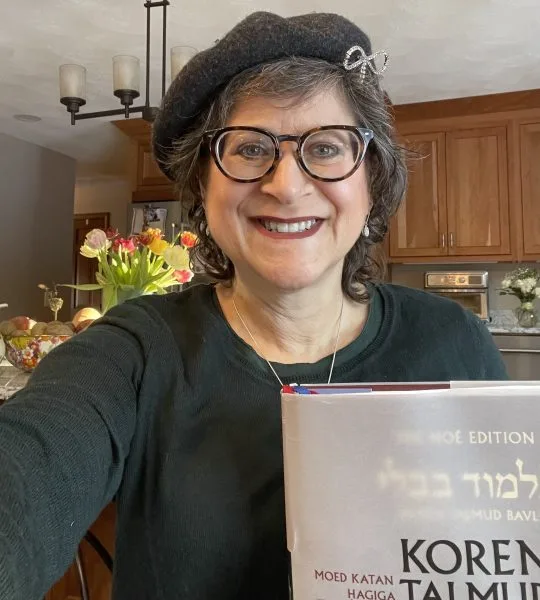Eruvin 3
לָא תַּיהֲנֵי לֵיהּ אֲמַלְתְּרָא, דְּהָא הֵיכָל אֲמַלְתְּרָא הַוְיָא לֵיהּ, וַאֲפִילּוּ הָכִי — עֶשְׂרִים אַמָּה הוּא דְּגָבוֹהַּ, דִּתְנַן: חָמֵשׁ אֲמַלְתְּרָאוֹת שֶׁל מֵילָה הָיוּ עַל גַּבָּיו, זוֹ לְמַעְלָה מִזּוֹ, וְזוֹ לְמַעְלָה מִזּוֹ.
a molded or protruding cornice [amaltera] crowning the entrance should not be effective in rendering an alleyway fit to carry within it if it is higher than twenty cubits, as the Sanctuary had a cornice, and even so it was twenty cubits high, and no more. As we learned in a mishna: Over it were five oak cornices, one protruding above the other.
וְהַאי מַאי תְּיוּבְתָּא? דִילְמָא כִּי תַּנְיָא הָהִיא דַּאֲמַלְתְּרָאוֹת, בָּאוּלָם תַּנְיָא?
The Gemara attempts to dismiss this difficulty: And, with regard to that mishna, what is the refutation? Perhaps when that mishna with regard to cornices was taught, it was taught with regard to the Entrance Hall, whose height was forty cubits, and not with regard to the Sanctuary.
וְהַאי מַאי קוּשְׁיָא? דִילְמָא תַּבְנִית הֵיכַל כְּתַבְנִית אוּלָם?
The Gemara responds: And what is the difficulty with that? Perhaps the design of the Sanctuary was like the design of the Entrance Hall. Just as there were cornices in one doorway, there were cornices in the other.
אַלְּמָה אָמַר רַבִּי אִילְעָא אָמַר רַב: רְחָבָה אַרְבָּעָה, אַף עַל פִּי שֶׁאֵינָהּ בְּרִיאָה. וְאִם יֵשׁ לָהּ אֲמַלְתְּרָא אֲפִילּוּ גְּבוֹהָה יוֹתֵר מֵעֶשְׂרִים אַמָּה אֵינוֹ צָרִיךְ לְמַעֵט.
The Gemara returns to its question with regard to a cornice: Why then did Rabbi Ile’a say that Rav himself said: If the width of a cross beam is four handbreadths, even if it is not sturdy, it renders the alleyway fit for carrying within it. And if it has a cornice, even if it is higher than twenty cubits, one need not diminish its height.
אָמַר רַב יוֹסֵף: אֲמַלְתְּרָא מַתְנִיתָא הִיא, מַאן קָתָנֵי לַהּ?
Rav Yosef said: This halakha with regard to a cornice was not actually stated by Rav, but rather it is a baraita. Who, in fact, teaches that baraita? Perhaps it is not an authoritative baraita, and Rav does not have to accept what it says.
אָמַר אַבָּיֵי: וְהָא חָמָא בְּרֵיהּ דְּרַבָּה בַּר אֲבוּהּ קָתָנֵי לַהּ, וְתִיהְוֵי אֲמַלְתְּרָא מַתְנִיתָא וְתִיקְשֵׁי לְרַב!
Abaye said: Isn’t it Ḥama, son of Rabba bar Avuh, who teaches it? And therefore, even if the halakha with regard to a cornice will be a baraita, it nevertheless poses a difficulty to Rav.
אָמַר לְךָ רַב: דַּל אֲנָא מֵהָכָא, מַתְנְיָיתָא מִי לָא קַשְׁיָין אַהֲדָדֵי? אֶלָּא מַאי אִית לָךְ לְמֵימַר — תַּנָּאֵי הִיא, לְדִידִי נָמֵי תַּנָּאֵי הִיא.
Rav could have said to you: Even if you eliminate me and my explanation from the discussion here, don’t the two baraitot themselves, the baraita that states that the Rabbis derive the dimensions of an entrance from the doorway of the Sanctuary and the baraita that states that in the case of a cornice, even if it is higher than twenty cubits, it need not be lowered, contradict each other? Rather, what have you to say to reconcile the contradiction? The matter is the subject of a dispute between tanna’im; so too, according to my opinion, it is the subject of a dispute between tanna’im.
רַב נַחְמָן בַּר יִצְחָק אָמַר: בְּלָא רַב — מַתְנְיָיתָא אַהֲדָדֵי לָא קַשְׁיָין: לְרַבָּנַן קוֹרָה טַעְמָא מַאי — מִשּׁוּם הֶיכֵּרָא, וְהַאי דְּקָתָנֵי ״יָתֵר מִפִּתְחוֹ שֶׁל הֵיכָל״ — סִימָנָא בְּעָלְמָא.
Rav Naḥman bar Yitzḥak said: Without Rav, the baraitot do not contradict each other, as according to the Rabbis, what is the reason that a cross beam renders an alleyway fit for carrying? Because it serves as a conspicuous marker between the alleyway and the public domain. Ordinarily a cross beam more than twenty cubits high is not noticeable; however, a cornice attracts attention even at that height. And that which is taught in the other baraita with regard to the height of a beam at the entrance to an alleyway: Greater than the entrance of the Sanctuary, is merely a mnemonic device. No actual halakhot are derived from the entrance of the Sanctuary.
וְרַב נַחְמָן בַּר יִצְחָק, הָנִיחָא אִי לָא סְבִירָא לֵיהּ הָא דְּרַבָּה, אֶלָּא אִי סְבִירָא לֵיהּ הָא דְּרַבָּה, דְּאָמַר רַבָּה, כְּתִיב: ״לְמַעַן יֵדְעוּ דוֹרוֹתֵיכֶם כִּי בַסֻּכּוֹת הוֹשַׁבְתִּי״, עַד עֶשְׂרִים אַמָּה אָדָם יוֹדֵעַ שֶׁדָּר בַּסּוּכָּה, לְמַעְלָה מֵעֶשְׂרִים אַמָּה אֵין אָדָם יוֹדֵעַ, מִשּׁוּם דְּלָא שָׁלְטָא בֵּיהּ עֵינָא.
The Gemara notes: And that the explanation of Rav Naḥman bar Yitzḥak works out well if he does not hold this opinion of Rabba; however, if he holds this opinion of Rabba, it is difficult. As Rabba said with regard to the fitness of a sukka whose roofing is higher than twenty cubits that it is written: “In order that your generations should know that I made the children of Israel dwell in booths when I brought them out of the land of Egypt; I am the Lord your God” (Leviticus 23:43). When the roofing of a sukka is up to twenty cubits high, a person is aware that he is dwelling in a sukka; however, when the roofing of the sukka is above twenty cubits, a person is not aware that he is dwelling in a sukka, because the eye does not discern the sukka roofing. One does not usually raise his head to look that high, and consequently, he sees the walls and does not notice the defining feature of the sukka, its roofing.
אַלְמָא גַּבֵּי סוּכָּה נָמֵי בְּהֶיכֵּרָא פְּלִיגִי, אִיפְּלוֹגֵי בְּתַרְתֵּי לְמָה לִי?
The Gemara explains the difficulty: Apparently, with regard to sukka as well, the Rabbis and Rabbi Yehuda disagree whether or not an item more than twenty cubits high is conspicuous. According to Rav Naḥman bar Yitzḥak, why do I need them to disagree about the same point in two cases, that of sukka and that of an alleyway? That the dispute between the Rabbis and Rabbi Yehuda with regard to sukka revolves around this issue indicates that their dispute with regard to an alleyway revolves around a different point, as asserted by Rav.
צְרִיכָא, דְּאִי אַשְׁמְעִינַן גַּבֵּי סוּכָּה — בְּהָא קָאָמַר רַבִּי יְהוּדָה כֵּיוָן דְּלִישִׁיבָה עֲבִידָא, שָׁלְטָא בֵּיהּ עֵינָא. אֲבָל מָבוֹי, דִּלְהִילּוּךְ עֲבִיד — אֵימָא מוֹדֶה לְהוּ לְרַבָּנַן. וְאִי אַשְׁמְעִינַן בְּהָא — בְּהָא קָאָמְרִי רַבָּנַן, אֲבָל בְּהָךְ אֵימָא מוֹדוּ לֵיהּ לְרַבִּי יְהוּדָה. צְרִיכָא.
The Gemara answers: It is necessary to teach both disputes, as had the mishna taught us only with regard to sukka, one might have thought that only in this case does Rabbi Yehuda say that an object is conspicuous even above twenty cubits; since a sukka is designed for extended dwelling, the eye undoubtedly discerns the roofing at some point. However, in the case of an alleyway, which is designed for walking, say that he concedes to the Rabbis that a person walking in an alleyway does not notice objects at so significant a height. And had the mishna taught us only with regard to that case of an alleyway, one might have thought that only in that case do the Rabbis say that people do not notice objects at so significant a height; however, in that case of sukka, say that they concede to Rabbi Yehuda, for the above-stated reason. Therefore, it is necessary to teach both disputes.
מַאי אֲמַלְתְּרָא? רַב חָמָא בְּרֵיהּ דְּרַבָּה בַּר אֲבוּהּ אָמַר: קִינֵּי. כִּי אֲתָא רַב דִּימִי אֲמַר, אָמְרִי בְּמַעְרְבָא: פִּסְקֵי דְאַרְזָא.
The Gemara seeks to arrive at a precise definition of amaltera, translated above as cornice. What is an amaltera? Rav Ḥama, son of Rabba bar Avuh, said: It refers to decorative wood carvings in the shape of birds’ nests. When Rav Dimi came from Eretz Yisrael to Babylonia, he said that they say in the West, Eretz Yisrael, it is referring to cedar poles.
מַאן דְּאָמַר פִּסְקֵי דְאַרְזָא, כׇּל שֶׁכֵּן קִינֵּי. מַאן דְּאָמַר קִינֵּי, אֲבָל פִּסְקֵי דְאַרְזָא לָא.
The Gemara explains: The one who said that amaltera refers to cedar poles would all the more so permit use of carvings of birds’ nests, as a cross beam engraved with images attracts attention and is noticeable even at a great height. However, the one who said that amaltera refers to carvings of birds’ nests would say that the halakha with regard to a cornice applies only to them, but not to cedar poles.
וּמַאן דְּאָמַר פִּסְקֵי דְאַרְזָא מַאי טַעְמָא — מִשּׁוּם דִּנְפִישׁ מְשָׁכֵיהּ. וְהָא סוּכָּה דִּנְפִישׁ מְשָׁכֵיהּ, וְקָאָמְרִי רַבָּנַן דְּלָא!
The Gemara clarifies the opinion of the one who said cedar poles. What is the reason for his opinion? He holds that since its length is great, a cedar pole attracts attention. But isn’t the length of a sukka great as well, and nevertheless, the Rabbis say that a sukka higher than twenty cubits is not fit?
אֶלָּא: כֵּיוָן דְּקָא חֲשִׁיב אִית לֵיהּ קָלָא.
Rather, the reason is as follows: Since a cedar pole is of significant value, it generates publicity. People passing through an alleyway stop and stare at a cross beam of that kind, even when it is higher than twenty cubits, leading others to do so as well.
מִקְצָת קוֹרָה בְּתוֹךְ עֶשְׂרִים, וּמִקְצָת קוֹרָה לְמַעְלָה מֵעֶשְׂרִים, מִקְצָת סְכָךְ בְּתוֹךְ עֶשְׂרִים, וּמִקְצָת סְכָךְ לְמַעְלָה מֵעֶשְׂרִים? אָמַר רַבָּה: בְּמָבוֹי כָּשֵׁר, בְּסוּכָּה פָּסוּל.
The Gemara raises a question: If part of the cross beam of an alleyway is within twenty cubits of the ground, and part of the cross beam is above twenty cubits, and similarly, if part of the roofing of a sukka is within twenty cubits, and part of the roofing is above twenty cubits, what is its legal status? Rabba said: In the case of an alleyway, it is fit; in the case of a sukka, it is unfit.
מַאי שְׁנָא בְּמָבוֹי דְּכָשֵׁר, דְּאָמְרִינַן קְלוֹשׁ? סוּכָּה נָמֵי לֵימָא קְלוֹשׁ!
The Gemara asks: What is different in the case of an alleyway that the ruling is that it is fit? It is because we say: Thin the part of the cross beam that is beyond twenty cubits, i.e., consider it as if it were not there. If so, in the case of sukka too, say: Thin the roofing that is beyond twenty cubits.
אִי קָלְשַׁתְּ — הָוְיָא לַהּ חֲמָתָהּ מְרוּבָּה מִצִּילָּתָהּ.
The Gemara answers: If you thin the roofing beyond twenty cubits, it will result in a sukka whose sun is more than its shade. Were the section of the roofing above twenty cubits removed, the roofing that remained would not provide sufficient shade for the sukka.
הָכָא נָמֵי, אִי קָלְשַׁתְּ הָוְיָא לַהּ קוֹרָה הַנִּיטֶּלֶת בָּרוּחַ. אֶלָּא עַל כׇּרְחָךְ, נַעֲשׂוּ כְּשַׁפּוּדִין שֶׁל מַתֶּכֶת. הָכָא נָמֵי — עַל כׇּרְחָךְ נַעֲשֵׂית צִילָּתָהּ מְרוּבָּה מֵחַמָּתָהּ!
The Gemara rejects this argument: Here too, in the case of a cross beam, if you thin the section above twenty cubits, it would become a weak and unstable cross beam that is removed by the wind, which does not render the alleyway fit for carrying within it. Rather, perforce, the status of the remaining parts of those cross beams becomes like that of metal skewers [shefudin], which, although they are thin, are not removed by the wind. Here too, in the case of a sukka, perforce, even after the upper roofing is removed, the status of the sukka becomes like that of a sukka whose shade is more than its sun.
אָמַר רָבָא מִפַּרְזַקְיָא: סוּכָּה דִּלְיָחִיד הִיא לָא מִדְּכַר, מָבוֹי דִּלְרַבִּים מַדְכְּרִי אַהֲדָדֵי.
The Gemara explains Rabba’s distinction differently. Rava from Parzakya said: A sukka, which is generally erected for an individual, if the portion of the roofing below twenty were removed and only the portion above twenty remained, he would not be reminded to lower the remaining roofing and would dwell in a sukka that is unfit. An alleyway, in contrast, which is used by many people, if the section of the cross beam below twenty cubits were removed, they would remind each other to remedy the situation.
רָבִינָא אָמַר: סוּכָּה דְּאוֹרָיְיתָא — אַחְמִירוּ בַּהּ רַבָּנַן, מָבוֹי דְּרַבָּנַן — לָא אַחְמִירוּ בֵּיהּ רַבָּנַן.
Ravina said a different explanation: With regard to a sukka, since its mitzva is by Torah law, the Sages were stringent. However, with regard to an alleyway, since the entire requirement to place a cross beam across the entrance in order to permit carrying in an alleyway is only by rabbinic law, the Sages were not stringent.
רַב אַדָּא בַּר מַתְנָה מַתְנֵי לְהָא שְׁמַעְתָּא דְּרַבָּה אִיפְּכָא. אָמַר רַבָּה: בְּמָבוֹי פָּסוּל, בְּסוּכָּה כְּשֵׁירָה!
The Gemara cites a different version of Rabba’s distinction: Rav Adda bar Mattana taught this halakha of Rabba in the opposite manner. Rabba said: In the case of an alleyway, it is unfit; in the case of a sukka, it is fit. As a result, all the previous explanations must be reversed.
מַאי שְׁנָא סוּכָּה דִּכְשֵׁירָה, דְּאָמְרִינַן קְלוֹשׁ? בְּמָבוֹי נָמֵי לֵימָא קְלוֹשׁ!
The Gemara asks: What is different in the case of a sukka that it is fit? Because we say: Thin the roofing that is beyond twenty cubits. If so, then in the case of a cross beam as well, let us say: Thin the part of the cross beam that is beyond twenty cubits.
אִי קְלַשַׁת, הָוֵי לַהּ קוֹרָה הַנִּיטֶּלֶת בְּרוּחַ. הָכָא נָמֵי, אִי קָלְשַׁתְּ — הָוְיָא לַהּ חֲמָתָהּ מְרוּבָּה מִצִּילָּתָהּ! אֶלָּא עַל כׇּרְחֲךָ, נַעֲשֵׂית צִילָּתָהּ מְרוּבָּה מֵחַמָּתָהּ, הָכָא נָמֵי, עַל כׇּרְחָךְ נַעֲשׂוּ כְּשַׁפּוּדִין שֶׁל מַתֶּכֶת!
The Gemara answers: If you thin the part beyond twenty cubits, it will become a weak and unstable cross beam that moves in the wind. The Gemara rejects this argument: Here too, in the case of a sukka, if you thin the upper section of the roofing, it would become a sukka whose sun is more than its shade. Rather, perforce, even after the upper roofing is removed, the status of the sukka becomes like that of a sukka whose shade is more than its sun; here too, in the case of an alleyway, perforce, the status of the remaining parts of those cross beams becomes like that of metal skewers, which, although they are thin, do not move in the wind.
אָמַר רָבָא מִפַּרְזַקְיָא: סוּכָּה דִּלְיָחִיד הִיא רָמֵי אַנַּפְשֵׁיהּ וּמִדְּכַר, מָבוֹי דִּלְרַבִּים הִיא סָמְכִי אַהֲדָדֵי וְלָא מִדַּכְרִי, דְאָמְרִי אִינָשֵׁי: קִדְרָא דְבֵי שׁוּתָּפֵי, לָא חַמִּימָא וְלָא קָרִירָא.
The Gemara offers a different explanation of Rabba’s distinction: Rava from Parzakya said: In the case of a sukka, which is generally erected for an individual, he casts responsibility upon himself and is reminded to make certain that the roofing is fit. In the case of an alleyway, which is used by many people, they are likely to rely upon each other and are not reminded to check the height of the cross beam. As people say: A pot belonging to partners is neither hot nor cold. When responsibility falls upon more than one person, each relies on the other, and ultimately the task is not completed.
רָבִינָא אָמַר: סוּכָּה דְּאוֹרָיְיתָא — לָא בָּעֵי חִיזּוּק. מָבוֹי דְּרַבָּנַן — בָּעֵי חִיזּוּק.
Ravina offered a different explanation and said: The mitzva of sukka, which is by Torah law, does not require reinforcement by the Sages, and consequently, they were lenient in that case. However, since the entire requirement to place a cross beam across the entrance to an alleyway is by rabbinic law, it requires reinforcement, and therefore the Sages were stringent.
מַאי הָוֵי עֲלַהּ? רַבָּה בַּר רַב עוּלָּא אָמַר: זֶה וָזֶה — פָּסוּל. רָבָא אָמַר: זֶה וָזֶה כָּשֵׁר.
Since there are two contradictory versions of Rabba’s statement, the Gemara inquires: What practical conclusion was reached about this problem, if part of the roofing of the sukka or the cross beam was above twenty cubits? Rabba bar Rav Ulla said: In that case, both this, an alleyway, and that, a sukka, are unfit. Rava said: Both this and that are fit,
חֲלַל סוּכָּה תְּנַן, חֲלַל מָבוֹי תְּנַן.
as that which we learned in the mishna, with regard to the unfitness of a sukka higher than twenty cubits, is referring to the interior space of the sukka; and that which we learned in the mishna, that a cross beam spanning an alleyway that is more than twenty cubits must be lowered, is referring to the space at the entrance of the alleyway beneath the cross beam.
אֲמַר לֵיהּ רַב פָּפָּא לְרָבָא, תַּנְיָא דִּמְסַיַּיע לָךְ: מָבוֹי שֶׁהוּא גָּבוֹהַּ מֵעֶשְׂרִים אַמָּה יוֹתֵר מִפִּתְחוֹ שֶׁל הֵיכָל יְמַעֵט. וְהֵיכָל גּוּפוֹ חֲלָלוֹ עֶשְׂרִים.
Rav Pappa said to Rava: A baraita was taught that supports your opinion: If the cross beam spanning the entrance of an alleyway is higher than twenty cubits off the ground, greater than the entrance of the Sanctuary, one must diminish its height. And the space of the entrance of the Sanctuary itself was twenty cubits high, and its roof was higher than twenty cubits. Apparently, the twenty cubits mentioned with regard to a sukka and an alleyway refers to the space beneath the roofing and the cross beam.
אֵיתִיבֵיהּ רַב שִׁימִי בַּר רַב אָשֵׁי לְרַב פָּפָּא: כֵּיצַד הָיָה עוֹשֶׂה — מַנִּיחַ קוֹרָה מִשְּׂפַת עֶשְׂרִים וּלְמַטָּה!
Rav Shimi bar Rav Ashi raised an objection to Rav Pappa from the Tosefta: How precisely would he do it? He places the cross beam from the edge of twenty cubits and below. Apparently, the entire cross beam must be within twenty cubits of the ground, and if any part of it rises above twenty it is unfit.
אֵימָא: ״וּלְמַעְלָה״. וְהָא ״לְמַטָּה״ קָתָנֵי!
Rav Pappa replied: Emend the Tosefta and say: From the edge of twenty cubits and above. Rav Shimi retorted: But isn’t it taught: And below? What justification is there to completely reverse the meaning of the Tosefta?
הָא קָא מַשְׁמַע לַן, דִּלְמַטָּה כִּלְמַעְלָה: מָה לְמַעְלָה חֲלָלָהּ עֶשְׂרִים, אַף לְמַטָּה חֲלָלָהּ עֲשָׂרָה.
Rava explained that there is no need to emend the language of the baraita, but merely to reinterpret it. The baraita is teaching us the following: The halakha below is like the halakha above. Just as above, with regard to the maximum height of the cross beam, it is the space beneath the cross beam that may not be more than twenty cubits, so too below, with regard to the minimum height of the cross beam, it is the space beneath the cross beam that may not be less than ten handbreadths. However, a cross beam placed within ten handbreadths of the ground is unfit and does not render it permitted to carry within the alleyway.
אָמַר אַבָּיֵי מִשְּׁמֵיהּ דְּרַב נַחְמָן: אַמַּת סוּכָּה וְאַמַּת מָבוֹי בְּאַמָּה בַּת חֲמִשָּׁה, אַמַּת כִּלְאַיִם בְּאַמָּה בַּת שִׁשָּׁה.
The Gemara considers the measure of the cubit mentioned in the mishna and elsewhere. Abaye said in the name of Rav Naḥman: The cubit mentioned with regard to the halakhot of sukka and the cubit mentioned in connection with the halakhot of an alleyway is a small cubit consisting of five handbreadths. In contrast, the cubit of a forbidden mixture of diverse kinds of seeds is a large cubit consisting of six handbreadths. Apparently, Rav Naḥman rules stringently in all cases.
אַמַּת מָבוֹי בְּאַמָּה בַּת חֲמִשָּׁה, לְמַאי הִלְכְתָא? לְגוֹבְהוֹ וּלְפִירְצַת מָבוֹי.
The Gemara elaborates: The cubit of an alleyway is a cubit consisting of five handbreadths. With regard to what halakha does this ruling apply? It applies to the issue of the height of the cross beam spanning an alleyway that may not be more than twenty cubits high, and to the breach of an alleyway that may not be more than ten cubits wide.
וְהָא אִיכָּא מֶשֶׁךְ מָבוֹי בְּאַרְבַּע אַמּוֹת, דִּלְקוּלָּא!
The Gemara poses a question: But isn’t there also the issue of the minimal length of an alleyway? For carrying in an alleyway to be rendered permissible by means of a side post or a cross beam, it must be at least four cubits long. In that case, measuring the alleyway with small cubits will lead to a leniency.
כְּמַאן דְּאָמַר בְּאַרְבָּעָה טְפָחִים.
The Gemara resolves this difficulty: Rav Naḥman holds in accordance with the one who said that the length of an alleyway need only be four handbreadths. However, a cubit mentioned in the context of an alleyway is always a small cubit, which is a stringency.
וְאִיבָּעֵית אֵימָא, בְּאַרְבַּע אַמּוֹת — וְרוֹב אַמּוֹת קָאָמַר.
The Gemara proposes an alternative solution: And if you wish, say instead that actually Rav Naḥman holds in accordance with the opinion that the length of an alleyway must be four cubits, and in that case, the alleyway is measured with large cubits of six handbreadths as a stringency. When he is saying that the cubit of an alleyway is a cubit of five handbreadths, he is speaking of most, but not all, cubits mentioned in the context of an alleyway.
אַמַּת סוּכָּה בְּאַמָּה בַּת חֲמִשָּׁה, לְמַאי הִלְכְתָא? לְגוֹבְהָהּ וּלְדוֹפֶן עֲקוּמָּה.
Rav Naḥman said that the cubit of a sukka is a small cubit consisting of five handbreadths. The Gemara asks: With regard to what halakha does this ruling apply? It applies to the halakha governing its height, i.e., that a sukka may not be more than twenty cubits high, and to the halakha of a curved wall. A sukka is considered valid if there are up to four cubits of invalid roofing, provided that this roofing is adjacent to one of the walls of the sukka. In that case, the invalid roofing is considered an extension of the wall, i.e., the wall is considered to be curved, and consequently, the entire sukka is valid. With regard to both halakhot, the ruling is stringent and distance is measured with small cubits.
וְהָא אִיכָּא מֶשֶׁךְ סוּכָּה בְּאַרְבַּע אַמּוֹת, דִּלְקוּלָּא! דְּתַנְיָא, רַבִּי אוֹמֵר: אוֹמֵר אֲנִי, כׇּל סוּכָּה שֶׁאֵין בָּהּ אַרְבַּע אַמּוֹת עַל אַרְבַּע אַמּוֹת פְּסוּלָה!
The Gemara asks: But isn’t there also the halakha of the minimal length of a sukka, which must be at least four cubits long? If it is measured with small cubits, that will lead to a leniency. As it was taught in a baraita: Rabbi Yehuda HaNasi says: I say, any sukka that does not have in it an area of at least four cubits by four cubits is invalid.
כְּרַבָּנַן, דְּאָמְרִי: אֲפִילּוּ אֵינָהּ מַחְזֶקֶת אֶלָּא רֹאשׁוֹ וְרוּבּוֹ וְשׁוּלְחָנוֹ.
The Gemara resolves this difficulty: Rav Naḥman holds in accordance with the opinion of the Rabbis, who say: A sukka is valid even if it holds only one’s head, most of his body, and his table.
וְאִיבָּעֵית אֵימָא: לְעוֹלָם רַבִּי הִיא, וְרוֹב אַמּוֹת קָאָמַר.
The Gemara suggests another solution: And if you wish, say instead: Actually, Rav Naḥman’s statement holds true even if it is in accordance with the opinion of Rabbi Yehuda HaNasi that a sukka must be at least four cubits long. Indeed, the sukka is measured with large cubits consisting of six handbreadths, which is a stringency. And when he says that the cubit of a sukka is a cubit of five handbreadths, he is speaking of most, but not all, cubits mentioned with regard to sukka.
אַמַּת כִּלְאַיִם בְּאַמָּה בַּת שִׁשָּׁה, לְמַאי הִילְכְתָא? לְקָרַחַת הַכֶּרֶם וְלִמְחוֹל הַכֶּרֶם.
The Gemara continues: As stated above, Rav Naḥman said that the cubit of a forbidden mixture of diverse kinds of seeds is a cubit consisting of six handbreadths. The Gemara asks: With regard to what halakha does this ruling apply? It applies to the halakha of a clearing in a vineyard and to the halakha of the perimeter of a vineyard.
דִּתְנַן: קָרַחַת הַכֶּרֶם, בֵּית שַׁמַּאי אוֹמְרִים: עֶשְׂרִים וְאַרְבַּע אַמּוֹת, וּבֵית הִלֵּל אוֹמְרִים: שֵׁשׁ עֶשְׂרֵה אַמּוֹת. וּמְחוֹל הַכֶּרֶם, בֵּית שַׁמַּאי אוֹמְרִים: שֵׁשׁ עֶשְׂרֵה אַמּוֹת, וּבֵית הִלֵּל אוֹמְרִים: שְׁתֵּים עֶשְׂרֵה אַמּוֹת.
As we learned in a mishna in tractate Kilayim: With regard to a clearing in a vineyard, Beit Shammai say: Its measure is twenty-four cubits, and Beit Hillel say: Sixteen cubits. With regard to the perimeter of a vineyard, Beit Shammai say: Sixteen cubits, and Beit Hillel say: Twelve cubits.
אֵיזוֹ הִיא קָרַחַת הַכֶּרֶם? כֶּרֶם שֶׁחָרַב אֶמְצָעִיתוֹ, אֵין שָׁם שֵׁשׁ עֶשְׂרֵה אַמּוֹת לֹא יָבִיא זֶרַע לְשָׁם. הָיוּ שָׁם שֵׁשׁ עֶשְׂרֵה אַמָּה — נוֹתֵן לוֹ כְּדֵי עֲבוֹדָתוֹ, וְזוֹרֵעַ אֶת הַמּוֹתָר.
The mishna explains: What is a clearing in a vineyard? It is referring to a vineyard whose middle section was laid bare of vines. If there are not sixteen cubits across in the clearing, one may not bring foreign seeds and sow them there, due to the Torah prohibition against sowing other crops in a vineyard (Deuteronomy 22:9). If there were sixteen cubits across in the clearing, one provides the vineyard with its requisite work area, i.e., four cubits along either side of the vines are left unsown to facilitate cultivation of the vines, and he sows the rest of the cleared area with foreign crops.
וְאֵיזֶהוּ מְחוֹל הַכֶּרֶם — בֵּין כֶּרֶם לַגָּדֵר. אֵין שָׁם שְׁתֵּים עֶשְׂרֵה אַמָּה, לֹא יָבִיא זֶרַע לְשָׁם. הָיוּ שָׁם שְׁתֵּים עֶשְׂרֵה אַמָּה — נוֹתֵן לוֹ כְּדֵי עֲבוֹדָתוֹ, וְזוֹרֵעַ אֶת הַשְּׁאָר.
The mishna continues: What is the perimeter of a vineyard? It is the vacant area between the vineyard and the fence surrounding it. If there are not twelve cubits in that area, one may not bring foreign seeds and sow them there. If there were twelve cubits in that area, he provides the vineyard, with its requisite work area, four cubits, and he sows the rest.
וְהָא אִיכָּא רְצוּפִים בְּאַרְבַּע אַמּוֹת, דִּלְקוּלָּא! דִּתְנַן: כֶּרֶם הַנָּטוּעַ עַל פָּחוֹת מֵאַרְבַּע אַמּוֹת, רַבִּי שִׁמְעוֹן אוֹמֵר: אֵינוֹ כֶּרֶם. וַחֲכָמִים אוֹמְרִים: כֶּרֶם, וְרוֹאִין אֶת הָאֶמְצָעִיִּים כְּאִילּוּ אֵינָם.
The Gemara raises a difficulty: But isn’t there also the halakha of vines that planted consecutively, within four cubits of each other, with regard to which measuring the distance with large cubits would lead to a leniency? As we learned in a mishna: With regard to a vineyard that was planted in consecutive rows with less than four cubits between them, Rabbi Shimon says: Since the rows are planted so closely together, it is not considered a vineyard, and if one plants other crops there he is not liable. And the Rabbis say: It is a vineyard, and one regards the middle vines, those planted between two appropriately spaced rows, as if they are not there. One who plants other crops there is indeed liable. According to Rabbi Shimon’s opinion, measuring the distance between the rows with large cubits leads to leniency.
כְּרַבָּנַן, דְּאָמְרִי הָוֵי כֶּרֶם. וְאִיבָּעֵית אֵימָא: לְעוֹלָם רַבִּי שִׁמְעוֹן, וְרוֹב אַמּוֹת קָאָמַר.
The Gemara resolves the difficulty: Rav Naḥman made his statement in accordance with the opinion of the Rabbis, who say that a densely planted vineyard is a vineyard. And if you wish, say instead: Actually, Rav Naḥman’s statement holds true even if it is in accordance with the opinion of Rabbi Shimon, that a densely planted vineyard is not a vineyard, and the distance between the rows is measured with small cubits consisting of five handbreadths as a stringency. When he says that the cubit of diverse kinds of seeds is a cubit consisting of six handbreadths, he is speaking of most, but not all, cubits mentioned with regard to a forbidden mixture of diverse kinds of seeds.
וְרָבָא מִשְּׁמֵיהּ דְּרַב נַחְמָן אָמַר: כׇּל אַמּוֹת בְּאַמָּה בַּת שִׁשָּׁה, אֶלָּא: הַלָּלוּ שׂוֹחֲקוֹת, וְהַלָּלוּ עֲצֵבוֹת.
The above was based on the ruling of Rav Naḥman according to Abaye. But Rava said in the name of Rav Naḥman: All cubits mentioned in measurements by the Sages consisted of a large cubit of six handbreadths. However, these, the cubits mentioned with regard to diverse kinds of seeds, are measured with expansive handbreadths, with the fingers spread apart, whereas those, the cubits mentioned with regard to an alleyway and a sukka, are measured with compressed handbreadths, with the fingers held together.
מֵיתִיבִי: כׇּל אַמּוֹת שֶׁאָמְרוּ חֲכָמִים בְּאַמָּה בַּת שִׁשָּׁה, וּבִלְבַד
The Gemara raises an objection from a baraita: All cubits that were mentioned by the Sages are cubits of six handbreadths, provided






















